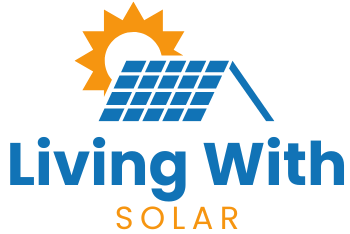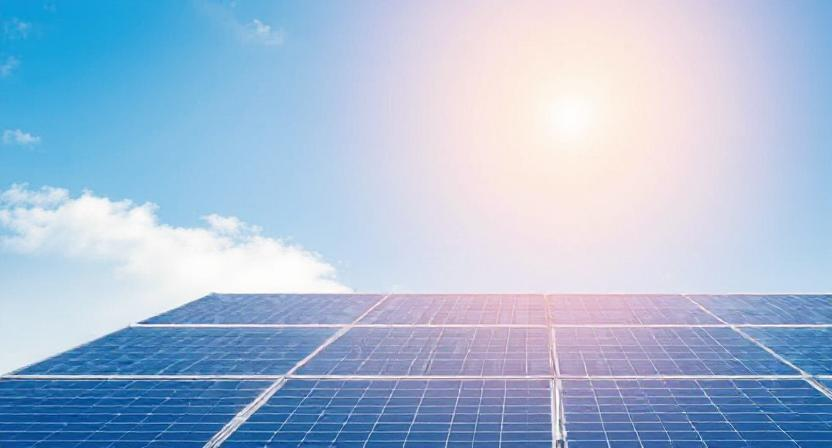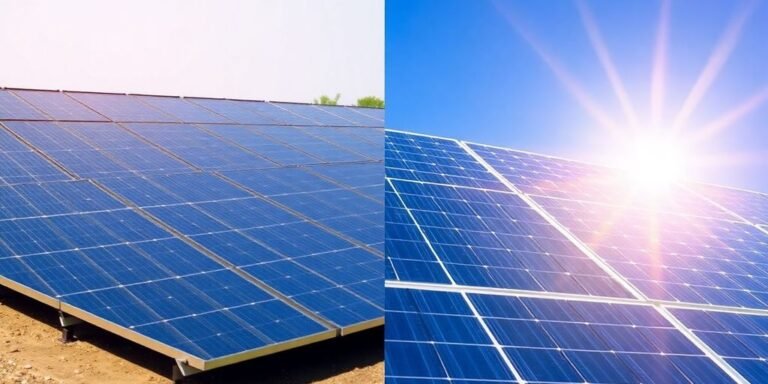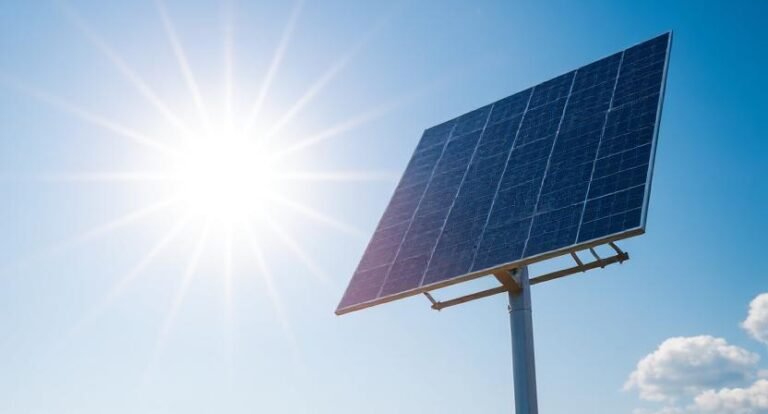When I think about solar energy and solar power, it’s clear they aren’t the same. Solar energy comes from the sun’s fusion. Solar power means turning that sunlight into electricity with photovoltaic cells. Solar energy includes all ways to use sunlight. Solar power specifically refers to generating electricity from that sunlight. There’s a lot more to learn about their differences and uses. I can’t wait to share more insights with you!
Understand the investment and financing options for solar energy.
🔗 Get Details
Key Takeaways
- Solar energy is the total energy from the sun. Solar power is about turning that energy into electricity.
- Solar energy includes different uses, like thermal energy. Solar power, however, focuses only on making electricity with photovoltaic cells.
- Solar energy works with photons from the sun. Solar power uses the photovoltaic effect to create electric current.
- Solar energy helps sustainability by cutting carbon emissions. Solar power also affects how we generate and use energy.
Understanding Solar Energy
Solar energy is the main source of power in our solar system. We can use it to meet our energy needs. The sun’s fusion process creates energy.
This energy releases many photons that travel to Earth. Photovoltaic cells turn sunlight into usable electricity. This shows how efficient solar power technology is.
The potential for sustainable energy is huge. Just 90 minutes of sunlight could power our whole civilization for a year! Beyond electricity generation, solar energy also includes thermal energy applications, demonstrating its versatility.
Using solar thermal systems or passive solar designs, we can harness sunlight. This approach paves the way for a cleaner and more sustainable future.
The possibilities are endless, and it’s exciting to explore them!
Defining Solar Power
Many people confuse solar energy with solar power. However, they refer to different ways of using sunlight. Solar power converts sunlight into electricity.
It mainly uses photovoltaic (PV) cells in solar panels. Solar power generates renewable energy. It can greatly reduce our reliance on fossil fuels.
Solar power production is measured in watts or kilowatts. This shows how much electricity is generated at a given moment.
Components like inverters and solar panels work together to manage energy flow effectively. Panel orientation and sunlight exposure affect how well solar power works.
These factors make solar energy a flexible and powerful option.
The Mechanism of Solar Energy

Solar energy is fascinating. It all starts in the Sun’s core. The Sun creates vast energy by fusing hydrogen.
This process makes photons that travel to Earth. When photons hit solar cells, they cause the photovoltaic effect. This process frees electrons and creates electric charges.
Here’s a quick overview of the processes involved:
Process Description
- Photon Interaction: Sunlight strikes solar cells.
- Electric Charges: These create Direct Current (DC).
- Generated by Solar Cells: DC needs conversion.
- Alternating Current (AC): Inverters convert DC for home use.
- Usable Solar Power: Power from the sun is now ready for use.
The success of this conversion depends on the quality of the solar cells and inverter. They turn sunlight into electricity efficiently.
How Solar Power Is Generated
Using sunlight’s power involves a cool process called the photovoltaic effect. Sunlight hits the semiconductor in solar cells.
This action frees electrons and creates an electric current. This electric current is direct current (DC). It needs conversion to alternating current (AC) for use in homes and businesses.
A typical solar panel system has many solar cells. There are usually 36 to 144 cells in each panel. This number depends on the design and energy needs.
Ultimately, solar power provides a sustainable solution for meeting our energy needs.
Key Technologies in Solar Energy
Solar power generation depends on advanced technologies. These improve efficiency and expand applications. A key technology in solar energy is photovoltaic systems.
These systems use solar cells made from silicon. These cells convert sunlight directly into electricity through the photovoltaic effect.
Another significant technology is solar thermal, where solar collectors capture sunlight to heat water or space. CSP systems use mirrors or lenses to focus sunlight.
This creates heat, which then generates electricity using a steam turbine. New solar technologies, such as thin-film solar cells and nanotech, boost efficiency.
They also lower costs, making solar energy easier to access. It’s exciting to see how these advancements are shaping the future of solar power!
Key Technologies in Solar Power

When I think about solar power, I can’t help but appreciate the key technologies that make it possible.
I find photovoltaic systems exciting, but I’m also interested in concentrating solar technologies. New innovations are pushing the limits of efficiency.
Let’s explore how these advancements are shaping the future of solar energy.
Photovoltaic Systems Overview
When looking at renewable energy, photovoltaic (PV) systems are unique. They can turn sunlight straight into electricity.
These systems utilize solar cells, primarily made of silicon, which generate electric current through the photovoltaic effect.
Typically, a PV panel consists of 36 to 144 solar cells that work together to produce direct current (DC) electricity from sunlight.
Inverters are crucial for making energy usable in homes and businesses. They convert direct current (DC) into alternating current (AC).
The efficiency of a PV system can change due to several factors. These include the type of inverter, the orientation of the panels, and how much sunlight they get.
Modern advancements, like thin-film materials and nanotechnology, are boosting solar energy systems.
Concentrating Solar Technologies
One more exciting way to use the sun’s energy is with Concentrating Solar Power (CSP) technologies. CSP systems focus sunlight using mirrors or lenses.
This creates heat, which is then turned into electricity, usually with a steam turbine. CSP has a major advantage: it can generate utility-scale power.
This is especially true when it uses thermal energy storage. So, it can produce electricity even when there’s no sunlight.
CSP systems can exceed 20% efficiency in ideal conditions. This makes them a strong choice for large-scale renewable energy. They are vital in today’s energy scene.
Emerging Solar Innovations
As the need for cleaner energy rises, I’m eager to look into new solar innovations. These changes are transforming the solar power scene.
Bifacial solar panels are leading the way, capturing sunlight on both sides and boosting energy generation by 10-20%. Meanwhile, perovskite solar cells are revolutionizing efficiency, with lab results showing over 25% efficiency while being cheaper to produce.
Solar tracking systems boost production by adjusting panels to follow the sun. This can increase output by as much as 30%.
Additionally, energy storage solutions, like lithium-ion batteries, allow us to store excess solar energy for later use.
Transparent solar panels could change windows and facades into energy-generating surfaces. This innovation expands how we use solar power in our daily lives.
Implications for Sustainability
The implications for sustainability are profound when we consider the change towards solar energy. Solar energy is a renewable resource.
It provides a sustainable alternative to fossil fuels. This helps to significantly lower carbon emissions. This transformation enhances energy security, as we become less reliant on traditional energy sources and benefit from price stability.
Communities using solar power are boosting economic growth. They are also becoming more resilient to energy shortages.
The minimal environmental impact of solar energy systems promotes cleaner air and water while supporting biodiversity. Also, saving on electricity bills helps households and businesses invest in greener practices. Embracing solar energy is an essential step towards a more sustainable future.
Evaluating Solar Solutions for Your Home
Shifting towards solar energy not only benefits the planet but also offers homeowners a chance to take control of their energy needs.
To find the best solar solution for my home, I started by checking my average monthly electricity usage in kilowatt-hours (kWh). This helped me decide on the right system size.
I also considered the average sunlight hours in my area, as they greatly impact the efficiency and energy output of the solar panels I choose to install.
To guarantee I accounted for potential inefficiencies, I factored in a 1.3 multiplier. Consulting with professional installers helped me navigate available grants and loans, making the initial solar installation more affordable. Understanding inverter types also maximized my system’s efficiency and overall performance.
Frequently Asked Questions
What Is the Difference Between Solar Energy and Solar Power?
When I think about solar energy and power, I see them as intertwined yet distinct. Solar energy encompasses all sunlight-derived forms, while solar power specifically refers to the electricity generated from that energy. It’s fascinating!
What’s the Difference Between Energy and Power?
Isn’t it fascinating how energy and power dance together? I’ve learned that energy’s the total work done, while power measures how fast that work happens. Understanding this helps me appreciate how my devices consume energy daily.
What Does Solar Power Mean?
When I think about solar power, I see it as harnessing sunlight to generate electricity. It’s amazing how sunlight can be converted into usable energy, making our world more sustainable and reducing reliance on fossil fuels.
Why Is My Electric Bill so High When I Have Solar Panels?
I’ve found that even with solar panels, bills can stay high. If my system’s too small, if there’s not enough sun, or if I use too much energy, I still end up paying more.





